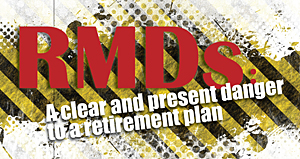Let’s review. Up to this point you’ve been contributing pre-tax dollars to a qualified plan. The money in your qualified plan has been increasing and decreasing based on the performance of the investments you have chosen in your plan. You have deferred the taxes due on the dollars you contributed to the plan as well as the taxes due on the growth in the account. Now it’s time to pay the piper.
The IRS was never going to allow you to defer paying your taxes indefinitely. Tax law says that when you reach a certain point in your life (it depends on your age, your employment status, and what type of retirement plan you have), you must begin to withdraw money from your retirement accounts. These withdrawals are known as distributions.
 You have determined how and when and how much you want to withdraw from your qualified plan. Hopefully, what you have planned doesn’t conflict with the IRS rules because, unfortunately for you, what you want is trumped by the IRS. The IRS stipulates the minimum amount that you are required to withdraw each year. Thus, Required Minimum Distributions (RMDs).
You have determined how and when and how much you want to withdraw from your qualified plan. Hopefully, what you have planned doesn’t conflict with the IRS rules because, unfortunately for you, what you want is trumped by the IRS. The IRS stipulates the minimum amount that you are required to withdraw each year. Thus, Required Minimum Distributions (RMDs).
The purpose of the required minimum distribution is to let the government tax the money you withdraw. You must start taking required minimum distributions by April 1st of the year following the calendar year you achieve age 70 ½. For example, if you turn 70 years of age on June 30, 2014, you achieve 70 ½ on December 30, 2014. You must take your first required minimum distribution (for 2014) by April 1, 2015. However, if you turn 70 years of age on July 1, 2014, you achieve 70 ½ on January 1, 2015. You do not have a required minimum distribution for 2014. Who makes these rules? It’s almost as if they are meant to intentionally confuse you.
To make matters worse, there is a critically important difference between IRAs and 401(k)s. If you have multiple IRAs you can add the account values together and take one RMD based on the total account value. Once you know the total amount of the RMD, you can withdraw that amount from one particular IRA or divide the RMD up among the IRAs as you see fit. A 403(b) is treated like an IRA.
However, if you have multiple 401(k)s, including a ROTH 401(k), you must take a RMD from each individual 401(k). Taking a RMD from just one 401(k), or from an IRA or 403(b), does not satisfy the RMD rules for 401(k)s, 457s, and Thrift Savings Plans. One way to avoid the requirement of multiple RMDs is to roll your old 401(k)s into one or more IRAs before you reach the age of RMDs.
 If you do not take the required minimum distribution for each year you are required you will have to pay a 50% penalty on the amount you should have taken, but did not take. For example, if your required minimum distribution is $25,000 and you do not take the distribution, the penalty is $12,500.
If you do not take the required minimum distribution for each year you are required you will have to pay a 50% penalty on the amount you should have taken, but did not take. For example, if your required minimum distribution is $25,000 and you do not take the distribution, the penalty is $12,500.
Something else to consider is because qualified plan withdrawals are considered income, they affect your entire tax situation. They can push you into a higher tax bracket and that, in turn, might affect your Medicare costs, cause your Social Security benefits to be taxable, or reduce your ability to qualify for certain tax deductions, further raising your taxes.
There are many rules regarding RMDs and as you can see they can be quite confusing. The best advice I can give you is this: Don’t try to manage your own RMD compliance program. Instead, hire a trained professional who is up-to-date on the latest RMD rules. The penalty for miscalculating your RMD is stiff (50% of the RMD); Too stiff to risk making a mistake.
If you’re interested in learning more about qualified plans download our FREE report entitled “Is Your IRA/401(k) a Ticking Time Bomb?” We also encourage you to contact us to schedule a time to talk about your specific circumstances.
Leave a Comment